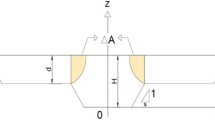Abstract
In overbank flow due to the interaction mechanism between the main channel and floodplain, the flow property of the compound sections gets affected. The complexity is more when the compound channels have non-prismatic floodplains. Additional complexity occurs during the interaction between the subsections as well as due to non-uniformity of flow through converging parts of the compound channel. For prediction of flow, calculation of energy loss parameters from section to section is an important task for river engineers. In this paper, an experimental investigation for the energy losses of converging compound channels for different flow depths along the converging path is performed. The loss of energy due to contraction and compound geometry for a compound channel is evaluated, and the dependency of energy loss for such channels is analyzed. A generalized multivariable regression model has been developed to predict the energy slope with high accuracy. Using the expression of the energy loss concept, the discharge capacity in the converging compound is found to provide good results as compared to other standard model exists in the literature.
Similar content being viewed by others
Abbreviations
- B :
-
Width of compound channel
- b :
-
Width of the main channel
- \(E_{1}\) :
-
Total energy heads of section 1
- \(E_{2}\) :
-
Total energy heads of section 2
- \(h_\mathrm{l}\) :
-
Energy loss
- h :
-
Height of the main channel
- H :
-
Bank full depth
- L :
-
Converging length
- R :
-
Hydraulic Radius
- \(S_{0}\) :
-
Bed slope
- \(S_\mathrm{e}\) :
-
Energy slope
- \(S_\mathrm{f}\) :
-
Friction slope
- \(V_{1}\) :
-
Mean flow velocities at section1
- \(V_{2}\) :
-
Mean flow velocities at section2
- \(Y_{1}\) :
-
Mean flow depths at section 1
- \(Y_{2}\) :
-
Mean flow depths at section 2
- \(Z_{1}\) :
-
Bed elevations above a given datum for section 1
- \(Z_{2}\) :
-
Bed elevations above a given datum for section 2
- \(\alpha \) :
-
Width ratio (B / b)
- \(\alpha _{1}\) :
-
correction factors for velocity head for section 1
- \(\alpha _{2}\) :
-
correction factors for velocity head for section 2
- \(\delta \) :
-
Aspect ratio (b / h)
- n :
-
Composite Roughness
- \(\beta \) :
-
Relative depth (\((H -h)/H\))
- \(\theta \) :
-
Angle of convergence
- \(X_\mathrm{r}\) :
-
Relative distance (x / L)
References
Bousmar, D.; Wilkin, N.; Jacquemart, J.H.; Zech, Y.: Overbank flow in symmetrically narrowing floodplains. J. Hydraul. Eng. ASCE 130(4), 305–312 (2004)
Proust, S.; Rivière, N.; Bousmar, D.; Paquier, A.; Zech, Y.; Morel, R.: Flow in compound channel with abrupt floodplain contraction. J. Hydraul. Eng. ASCE 132(9), 958–70 (2006)
Rezaei, B.: Overbank flow in compound channels with prismatic and non-prismatic floodplains. Ph.D. thesis, University of Birmingham, U.K (2006)
Knight, D.W.; Dometriou, J.D.: Floodplain and main channel flow interaction. J. Hydraul. Eng. 109(HY), 1073–1092 (1983)
Shiono, K.; Knight, D.W.: Turbulent open channel flows with variable depth across the channel. J. Fluid Mech. 222, 617–646 (1991)
Khatua, K.K.; Patra, K.C.: Boundary shear stress distribution in compound open channel flow. J. Hydraul. Eng. ISH 12(3), 39–55 (2008)
Khatua, K.K.; Patra, K.C.; Mohanty, P.K.: Stage discharge prediction for straight and smooth compound channels with wide floodplains. J. Hydraul. Eng. ASCE 138, 93–99 (2012)
Knight, D.W.; Shiono, K.: River channel and floodplain hydraulics. Floodplain Process. 5, 139–181 (1996)
Cater, J.E.; Williams, J.J.R.: Large eddy simulation of a long asymmetric compound open channel. J. Hydraul. Res. IAHR 46(4), 445–453 (2008)
Jazizadeh, F.; Zarrati, A.R.: Development of a three-dimensional numerical model to solve shallow-water equations compound channels. Can. J. Civ. Eng. 35(9), 963–974 (2008)
Marjang, N.; Merkley, G.P.: Velocity profile modeling in rectangular and compound open-channel cross sections. Irrig. Sci. 27(6), 471–484 (2009)
Hager, W.H.: Discharge characteristics of a local discontinuous contraction (part II). J. Hydraul. Res. IAHR 25(2), 197–214 (1987)
Molinas, A.; Marcus, K.B.: Choking in water supply structures and open channels. J. Hydraul. Res. IAHR 36(4), 675–694 (1998)
Naik, B.; Khatua, K.K.; Wright, N.G.; Sleigh, A.: Stage-discharge prediction for converging compound channels with narrow floodplains. J. Irrig. Drain. Eng. 143(8), 04017017 (2017)
Naik, B.; Khatua, K.K.: Boundary shear stress distribution for a converging compound channel. ISH J. Hydraul. Eng. 22(2), 212–219 (2016)
Naik, B.; Khatua, K.K.: Water surface profile computation for compound channels with narrow flood plains. Arab. J. Sci. Eng. 42(3), 941–955 (2017)
Author information
Authors and Affiliations
Corresponding author
Rights and permissions
About this article
Cite this article
Naik, B., Khatua, K.K., Padhi, E. et al. Loss of Energy in the Converging Compound Open Channels. Arab J Sci Eng 43, 5119–5127 (2018). https://doi.org/10.1007/s13369-017-2963-7
Received:
Accepted:
Published:
Issue Date:
DOI: https://doi.org/10.1007/s13369-017-2963-7




